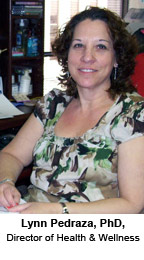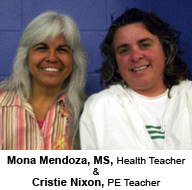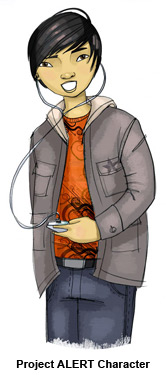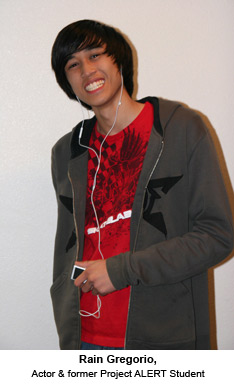New Mexico draws visitors to its endless sunshine and languid blue skies, dry desert air, fine Southwest cuisine, and rich native culture. The Land of Enchantment is just that.
But roiling underneath are serious problems related to poverty, gang violence, and drugs. New Mexico is one of the nation’s top three states for drug-related deaths. Alcohol-related deaths are seventy percent higher than the national average, yet tribal police view methamphetamine as an even greater threat to native populations.
Drug problems are especially serious among teens and pre-teens. The state ranks in the top five for current cocaine and marijuana use by teens, and for lifetime use of heroin and methamphetamine. By age thirteen, one in three children is using alcohol and one in five is already smoking pot.
Alarm bells are ringing, and educators in Albuquerque hear them. With an area-wide population that will soon top one million, the public schools in the state’s largest city are fighting back, determined to curb teen drug usage and prevent adult addiction. Project ALERT is one of their chief weapons.
Currently the program is offered in eleven of the city’s twenty-eight middle schools, in either sixth or seventh grade health class. “If at all possible, we hope that one day all our middle school students will get Project ALERT,” says Lynn Pedraza, PhD, Director of Health & Wellness for the Albuquerque Public Schools. “We have continued each year to increase the number of schools offering it, so we’re making steady progress. We’re fortunate to have support from a federal grant because right now school officials feel the district can’t afford it. Grants don’t last, so we have to continually look for additional funding.”
 Currently financial assistance comes from a US Department of Education’s Safe Schools/Healthy Students four-year grant. Amelia Lopez, MA, one of two full-time prevention/intervention coordinators for the Albuquerque Public Schools, devotes half time to Project ALERT.
Currently financial assistance comes from a US Department of Education’s Safe Schools/Healthy Students four-year grant. Amelia Lopez, MA, one of two full-time prevention/intervention coordinators for the Albuquerque Public Schools, devotes half time to Project ALERT.
“The first time I sat in on a classroom session I witnessed how much the students were learning,” she says. “Each lesson built on the previous one. Students actively participated, instead of passively listening to a teacher talk. This is a strong program and it meets our state standards, which is a selling point with schools wanting to offer it.”
Team Teaching at Truman Middle School
Lopez’s enthusiasm for the program has been instrumental in getting Project ALERT off the ground at Truman Middle School, where the entire student body receives reduced or free lunches. Most Truman students speak Spanish at home.
“Amelia is very supportive,” says Mona Mendoza, MS, Truman health teacher. “She gets us anything we need to teach Project ALERT, right down to copy paper. She even found us an easel.”
Mendoza team teaches Project ALERT with Cristie Nixon, Truman physical education instructor, and Pat Halama, sixth grade counselor. Together they have 64 sixth graders in the class, which was offered at Truman for the first time during the 2009-10 school year.
“In the beginning, neither of us was excited about undertaking this,” says Mendoza. “It felt like one more thing we had to do. I was initially concerned about teaching with fidelity, but I got past that quickly. During the training I learned the reasons why lessons are presented a certain way.”
“We’re committed to it now,” says Nixon. “Project ALERT engages the kids. They’re eleven and twelve and were shy and embarrassed when we started, but even the reluctant learners got into it quickly.”
Both teachers know that drugs are a reality in their students’ lives. “Pot is the drug of choice here,” Nixon says. “It’s very easy to get. I caught a student with it yesterday. She told me she took it from her mom.”
Though Mendoza and Nixon are not aware of students using methamphetamine, they pay careful attention because many students come from families suffering fallout from this drug and others. “Half our students have some experience with drugs in their lives,” says Mendoza. “Roughly a fifth of my one-hundred-plus students have parents or guardians incarcerated or involved in illegal or inappropriate activity, primarily gangs and drugs. Families in this area are the working poor. Many of our students are part of multi-generational families headed by single parents. Their lives can be chaotic. They do not lack for love, attention, or support—it’s just different from mainstream America. A student will say, ‘I don’t have my homework because I didn’t stay at my house last night. My mom didn’t come home so I went to stay with my auntie but I left my homework at my house.’”
Mendoza and Nixon adapt to this reality, capitalizing on Project ALERT ‘s emphasis on helping students make good choices. “My philosophy,” says Mendoza, “is that you teach students the skills to make good choices, to survive and flourish in whatever situation they are given. You take what you have and you move forward. I tell them to ask themselves every morning, ‘What do I need for school today? Do I have my homework?’ We’re helping them become successful.”
“One of the great things about Project ALERT,” adds Nixon, “is that it helps kids talk to their parents about drugs. It’s very powerful. When one of my students asked her mother about her own early experience with drugs, the mother replied that she was pressured to do them. That opened up a new level of communication between the two of them.”
According to both teachers, 80 to 90 percent of students complete the Project ALERT homework—an impressive return rate. “They’re very receptive to the information. Even our reluctant learners,” Mendoza says. “Project ALERT teaches them consequences and also the skills that help them say no.”
Project ALERT and At-Risk Students
Project ALERT is also helping some at-risk students become more responsible. At Vision Quest Alternative Middle School in Albuquerque, the students may look like other middle-schoolers, but they’ve been suspended from their regular schools. They’ve gotten in trouble for any number of reasons, among them disruptive conduct, assault, or possession of drugs. Some live with grandparents or in foster homes. Young as they are, a significant number have parole officers. Every student sees a counselor or therapist individually and also participates in once-a-week group counseling sessions.
They arrive at Vision Quest with gaps in their learning and often with anger issues. Some are involved with one of the hundred gangs estimated by the Albuquerque Police Department to operate in the city.
 “When you bring together at-risk students, you have challenges you don’t find in other schools,” says Carol Garcia, MA, LPCC, Vision Quest’s counselor, who teaches Project ALERT.
“When you bring together at-risk students, you have challenges you don’t find in other schools,” says Carol Garcia, MA, LPCC, Vision Quest’s counselor, who teaches Project ALERT.
Faculty and staff at Vision Quest focus on helping students prepare for the transition back to their original middle schools. Classes are never larger than twelve. Students work on catching up academically. They also work on learning to take responsibility for their actions, once they understand that the behaviors that brought them to Vision Quest need to change if they’re going to be successful in any school.
According to Garcia, Project ALERT can help. But guiding them through the lessons requires finesse on the part of teachers and staff if students are already drug savvy. Some are more than casual users, and marijuana is their drug of choice.
Says Garcia, “They come from families who are users. One of the Project ALERT videos shows young people partying at a home while the parents are away. My kids laugh because in their experience, drugs can be a family affair. They’ll say things like, ‘those kids are too good,’ because they don’t know kids like that. They’ll talk about how parents hold it together when they drive high or drunk. When we talk about smoking pot, they’ll bring up ‘hot boxing,’ where they roll up the windows in the car so that the smoke from pot will give them a more intensive high. They share what’s really going on out there.”
But, Garcia says, even when they think they know it all, they learn things in Project ALERT that surprise them. “We talk about how drugs can cause major organ damage or death. They don’t believe it—no one’s mentioned the possibility of death to them before. Yet when I ask them how many of them know someone who drinks a quart or more of alcohol a day, they all raise their hands. Most of them have lost somebody to drugs. That leads to discussion about tapering back and how you can get in less trouble and do your studies better if you use less.”
This is when Garcia has seen breakthroughs. “They’ll challenge their most-addicted classmates to try it. The more knowledgeable kids can become reflective about their own addictions,” she says.
“Project ALERT is hands-on. The students get involved and they learn. They talk to their parent or another significant adult in their lives. It opens up communication. The skits are especially popular—the girls are all drama and play acting and they really get into them.”
According to Garcia, students leave the program with a true understanding of the role drugs play in their lives, the damage these drugs do—and the tools to resist. To use or not to use becomes a choice instead of a foregone conclusion.
Garcia, who’s been in education for thirty-nine years, fosters an atmosphere of trust in her classroom. Students agree to keep confidential what’s shared in class. Gang activity stays outside the door. Students must say hello and goodbye to each other and respectfully listen to each other. Garcia celebrates their birthdays with a cake and presents them with an official certificate when they complete Project ALERT. She does whatever she can to prepare them for a successful reentry to their old schools—basics like doing homework and learning to avoid teachers or administrators who will write them up as behavior problems just to get them out of the school. She coaches them on what to say and do when old friends offer them drugs.
Garcia shares the story of a student who has applied to the New Mexico Military Institute. “When he came to us he was on parole and experimenting with pot. He had to do a urinalysis every week. In our Project ALERT class he was able to talk about what had happened to him and how it affected him. He was determined to get clean. We were all thrilled when he passed the Institute’s entrance exam. I think he now has the direction he needs to succeed, and Project ALERT helped.”
That’s exactly why the school system’s health and wellness director, Lynn Pedraza, is determined to continue to the search for funding to keep and continue to expand the number of schools offering Project ALERT.
“We have a high-needs population in this community. I believe very strongly that you give kids information to help them make smart choices,” she says. “We know anecdotally from student journals and teacher feedback that this program is impacting our students. We’ll stick with this. The school staff likes Project ALERT.”
--
Conrad N. Hilton, New Mexico Military Acadamy Alumnus
Project ALERT is made possible by generous grant support from the Conrad N. Hilton Foundation so it is interesting to note that it’s founder Conrad Hilton was born in the New Mexico Territory in 1887. He helped his father turn the family’s adobe house into an inn for traveling salesmen and then ran the inn until 1918 when, after his father’s death, he branched out to buy several hotels in Texas.
Conrad N. Hilton attended the New Mexico Military Academy, just as the student helped by Vision Quest’s Carol Garcia now will.
--
*Note about Vision Quest's adaptation
by Isabel Burk, MS, CPP, CHES
Project ALERT is a universal prevention program designed for the middle school population at-large. All our validation studies are based on outcomes from students in mainstream classrooms, teaching PA with fidelity to the model.
The field of prevention exists along a continuum. Universal programs such as Project ALERT are aimed at all students in a particular population, in this case, middle school. Selective prevention strategies target specific subsets at a higher risk than the general population, such as youth experiencing substantial academic failure or children of chemically dependent parents. Indicated prevention programs aim to identify youth exhibiting problem behaviors, and use specific strategies to prevent further problems or usage. Any school considering adopting a program should carefully assess their needs and select an evidence-based program that matches it most closely.
Albuquerque’s Vision Quest Alternative Middle School enrolls only suspended students. This selective population has more risk factors than the general population, and requires additional support. Their students take academic subjects in small groups, and receive individual and group counseling. PA is not an indicated prevention program or an early intervention program, but Vision Quest’s dedicated staff has been able to use it successfully to help their students understand how drugs affect people, families and lives.
Project ALERT’s clear “no use” message opens up new possibilities to youth who may not have considered abstinence to be a realistic choice. In the hands of experienced counselor Carol Garcia, youth share what’s really going on in their world. She guides her groups to discuss the benefits of cutting back on drinking or drugging, “how you can get in less trouble and do your studies better if you use less.”
While discussions of this nature do not fit the Project ALERT model, this indicated population has additional needs far beyond the scope of PA’s goals. The Vision Quest adaptation is not recommended for the general school population, but it is serving their high-risk student group well.
But roiling underneath are serious problems related to poverty, gang violence, and drugs. New Mexico is one of the nation’s top three states for drug-related deaths. Alcohol-related deaths are seventy percent higher than the national average, yet tribal police view methamphetamine as an even greater threat to native populations.
Drug problems are especially serious among teens and pre-teens. The state ranks in the top five for current cocaine and marijuana use by teens, and for lifetime use of heroin and methamphetamine. By age thirteen, one in three children is using alcohol and one in five is already smoking pot.

Alarm bells are ringing, and educators in Albuquerque hear them. With an area-wide population that will soon top one million, the public schools in the state’s largest city are fighting back, determined to curb teen drug usage and prevent adult addiction. Project ALERT is one of their chief weapons.
Currently the program is offered in eleven of the city’s twenty-eight middle schools, in either sixth or seventh grade health class. “If at all possible, we hope that one day all our middle school students will get Project ALERT,” says Lynn Pedraza, PhD, Director of Health & Wellness for the Albuquerque Public Schools. “We have continued each year to increase the number of schools offering it, so we’re making steady progress. We’re fortunate to have support from a federal grant because right now school officials feel the district can’t afford it. Grants don’t last, so we have to continually look for additional funding.”
 Currently financial assistance comes from a US Department of Education’s Safe Schools/Healthy Students four-year grant. Amelia Lopez, MA, one of two full-time prevention/intervention coordinators for the Albuquerque Public Schools, devotes half time to Project ALERT.
Currently financial assistance comes from a US Department of Education’s Safe Schools/Healthy Students four-year grant. Amelia Lopez, MA, one of two full-time prevention/intervention coordinators for the Albuquerque Public Schools, devotes half time to Project ALERT.“The first time I sat in on a classroom session I witnessed how much the students were learning,” she says. “Each lesson built on the previous one. Students actively participated, instead of passively listening to a teacher talk. This is a strong program and it meets our state standards, which is a selling point with schools wanting to offer it.”
Team Teaching at Truman Middle School
Lopez’s enthusiasm for the program has been instrumental in getting Project ALERT off the ground at Truman Middle School, where the entire student body receives reduced or free lunches. Most Truman students speak Spanish at home.
“Amelia is very supportive,” says Mona Mendoza, MS, Truman health teacher. “She gets us anything we need to teach Project ALERT, right down to copy paper. She even found us an easel.”
Mendoza team teaches Project ALERT with Cristie Nixon, Truman physical education instructor, and Pat Halama, sixth grade counselor. Together they have 64 sixth graders in the class, which was offered at Truman for the first time during the 2009-10 school year.

“In the beginning, neither of us was excited about undertaking this,” says Mendoza. “It felt like one more thing we had to do. I was initially concerned about teaching with fidelity, but I got past that quickly. During the training I learned the reasons why lessons are presented a certain way.”
“We’re committed to it now,” says Nixon. “Project ALERT engages the kids. They’re eleven and twelve and were shy and embarrassed when we started, but even the reluctant learners got into it quickly.”
Both teachers know that drugs are a reality in their students’ lives. “Pot is the drug of choice here,” Nixon says. “It’s very easy to get. I caught a student with it yesterday. She told me she took it from her mom.”
Though Mendoza and Nixon are not aware of students using methamphetamine, they pay careful attention because many students come from families suffering fallout from this drug and others. “Half our students have some experience with drugs in their lives,” says Mendoza. “Roughly a fifth of my one-hundred-plus students have parents or guardians incarcerated or involved in illegal or inappropriate activity, primarily gangs and drugs. Families in this area are the working poor. Many of our students are part of multi-generational families headed by single parents. Their lives can be chaotic. They do not lack for love, attention, or support—it’s just different from mainstream America. A student will say, ‘I don’t have my homework because I didn’t stay at my house last night. My mom didn’t come home so I went to stay with my auntie but I left my homework at my house.’”
Mendoza and Nixon adapt to this reality, capitalizing on Project ALERT ‘s emphasis on helping students make good choices. “My philosophy,” says Mendoza, “is that you teach students the skills to make good choices, to survive and flourish in whatever situation they are given. You take what you have and you move forward. I tell them to ask themselves every morning, ‘What do I need for school today? Do I have my homework?’ We’re helping them become successful.”
“One of the great things about Project ALERT,” adds Nixon, “is that it helps kids talk to their parents about drugs. It’s very powerful. When one of my students asked her mother about her own early experience with drugs, the mother replied that she was pressured to do them. That opened up a new level of communication between the two of them.”
According to both teachers, 80 to 90 percent of students complete the Project ALERT homework—an impressive return rate. “They’re very receptive to the information. Even our reluctant learners,” Mendoza says. “Project ALERT teaches them consequences and also the skills that help them say no.”
Project ALERT and At-Risk Students
Project ALERT is also helping some at-risk students become more responsible. At Vision Quest Alternative Middle School in Albuquerque, the students may look like other middle-schoolers, but they’ve been suspended from their regular schools. They’ve gotten in trouble for any number of reasons, among them disruptive conduct, assault, or possession of drugs. Some live with grandparents or in foster homes. Young as they are, a significant number have parole officers. Every student sees a counselor or therapist individually and also participates in once-a-week group counseling sessions.
They arrive at Vision Quest with gaps in their learning and often with anger issues. Some are involved with one of the hundred gangs estimated by the Albuquerque Police Department to operate in the city.
 “When you bring together at-risk students, you have challenges you don’t find in other schools,” says Carol Garcia, MA, LPCC, Vision Quest’s counselor, who teaches Project ALERT.
“When you bring together at-risk students, you have challenges you don’t find in other schools,” says Carol Garcia, MA, LPCC, Vision Quest’s counselor, who teaches Project ALERT. Faculty and staff at Vision Quest focus on helping students prepare for the transition back to their original middle schools. Classes are never larger than twelve. Students work on catching up academically. They also work on learning to take responsibility for their actions, once they understand that the behaviors that brought them to Vision Quest need to change if they’re going to be successful in any school.
According to Garcia, Project ALERT can help. But guiding them through the lessons requires finesse on the part of teachers and staff if students are already drug savvy. Some are more than casual users, and marijuana is their drug of choice.
Says Garcia, “They come from families who are users. One of the Project ALERT videos shows young people partying at a home while the parents are away. My kids laugh because in their experience, drugs can be a family affair. They’ll say things like, ‘those kids are too good,’ because they don’t know kids like that. They’ll talk about how parents hold it together when they drive high or drunk. When we talk about smoking pot, they’ll bring up ‘hot boxing,’ where they roll up the windows in the car so that the smoke from pot will give them a more intensive high. They share what’s really going on out there.”
But, Garcia says, even when they think they know it all, they learn things in Project ALERT that surprise them. “We talk about how drugs can cause major organ damage or death. They don’t believe it—no one’s mentioned the possibility of death to them before. Yet when I ask them how many of them know someone who drinks a quart or more of alcohol a day, they all raise their hands. Most of them have lost somebody to drugs. That leads to discussion about tapering back and how you can get in less trouble and do your studies better if you use less.”
This is when Garcia has seen breakthroughs. “They’ll challenge their most-addicted classmates to try it. The more knowledgeable kids can become reflective about their own addictions,” she says.
“Project ALERT is hands-on. The students get involved and they learn. They talk to their parent or another significant adult in their lives. It opens up communication. The skits are especially popular—the girls are all drama and play acting and they really get into them.”
According to Garcia, students leave the program with a true understanding of the role drugs play in their lives, the damage these drugs do—and the tools to resist. To use or not to use becomes a choice instead of a foregone conclusion.
Garcia, who’s been in education for thirty-nine years, fosters an atmosphere of trust in her classroom. Students agree to keep confidential what’s shared in class. Gang activity stays outside the door. Students must say hello and goodbye to each other and respectfully listen to each other. Garcia celebrates their birthdays with a cake and presents them with an official certificate when they complete Project ALERT. She does whatever she can to prepare them for a successful reentry to their old schools—basics like doing homework and learning to avoid teachers or administrators who will write them up as behavior problems just to get them out of the school. She coaches them on what to say and do when old friends offer them drugs.
Garcia shares the story of a student who has applied to the New Mexico Military Institute. “When he came to us he was on parole and experimenting with pot. He had to do a urinalysis every week. In our Project ALERT class he was able to talk about what had happened to him and how it affected him. He was determined to get clean. We were all thrilled when he passed the Institute’s entrance exam. I think he now has the direction he needs to succeed, and Project ALERT helped.”
That’s exactly why the school system’s health and wellness director, Lynn Pedraza, is determined to continue to the search for funding to keep and continue to expand the number of schools offering Project ALERT.
“We have a high-needs population in this community. I believe very strongly that you give kids information to help them make smart choices,” she says. “We know anecdotally from student journals and teacher feedback that this program is impacting our students. We’ll stick with this. The school staff likes Project ALERT.”
--
Conrad N. Hilton, New Mexico Military Acadamy Alumnus
Project ALERT is made possible by generous grant support from the Conrad N. Hilton Foundation so it is interesting to note that it’s founder Conrad Hilton was born in the New Mexico Territory in 1887. He helped his father turn the family’s adobe house into an inn for traveling salesmen and then ran the inn until 1918 when, after his father’s death, he branched out to buy several hotels in Texas.
Conrad N. Hilton attended the New Mexico Military Academy, just as the student helped by Vision Quest’s Carol Garcia now will.
--
*Note about Vision Quest's adaptation
by Isabel Burk, MS, CPP, CHES
Project ALERT is a universal prevention program designed for the middle school population at-large. All our validation studies are based on outcomes from students in mainstream classrooms, teaching PA with fidelity to the model.
The field of prevention exists along a continuum. Universal programs such as Project ALERT are aimed at all students in a particular population, in this case, middle school. Selective prevention strategies target specific subsets at a higher risk than the general population, such as youth experiencing substantial academic failure or children of chemically dependent parents. Indicated prevention programs aim to identify youth exhibiting problem behaviors, and use specific strategies to prevent further problems or usage. Any school considering adopting a program should carefully assess their needs and select an evidence-based program that matches it most closely.
Albuquerque’s Vision Quest Alternative Middle School enrolls only suspended students. This selective population has more risk factors than the general population, and requires additional support. Their students take academic subjects in small groups, and receive individual and group counseling. PA is not an indicated prevention program or an early intervention program, but Vision Quest’s dedicated staff has been able to use it successfully to help their students understand how drugs affect people, families and lives.
Project ALERT’s clear “no use” message opens up new possibilities to youth who may not have considered abstinence to be a realistic choice. In the hands of experienced counselor Carol Garcia, youth share what’s really going on in their world. She guides her groups to discuss the benefits of cutting back on drinking or drugging, “how you can get in less trouble and do your studies better if you use less.”
While discussions of this nature do not fit the Project ALERT model, this indicated population has additional needs far beyond the scope of PA’s goals. The Vision Quest adaptation is not recommended for the general school population, but it is serving their high-risk student group well.



